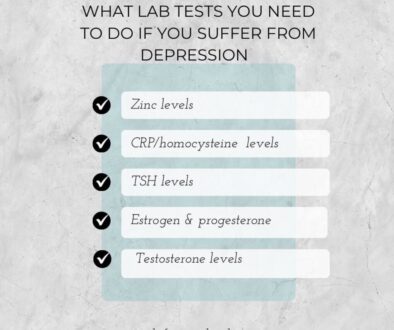Weight Loss: A Naturopathic Perspective
Weight loss can seem like an uphill battle, with so much confusing advice about dieting.
The science does appear to be quite consistent with the medical risks associated with
weight gain such as obesity, cardiovascular disease, type 2 diabetes, certain cancers, and
overall lowered vitality. A study published showed that women who lose weight after their
50s have a lower risk of developing breast cancer than those who do not lose
weight. 1 Research has shown that losing even just a few kilograms of weight minimizes the
risk of developing diabetes by up to fifty percent. 2 Another study showed that dyslipidemia,
hypertension, sleep apnea, difficulty breathing, cardiovascular diseases, and certain types
of cancers are associated with obesity. 3 Besides the medical benefits, improving body
composition and maintaining a healthy weight may contribute to improved psychological
wellbeing and feelings of vitality. 4 While calorie restriction is effective and necessary to
reduce weight, it only seems logical that to do it effectively requires a holistic approach.
Nutritional and lifestyle science is continuously looking at other aspects like metabolism,
our circadian rhythm, our resting energy expenditure, or how we can mitigate food cravings.
How Much Weight Loss per Week Is Considered a Healthy Target?
Losing a lot of weight at once may feel good; however, it is becoming clear that such drastic
measures on the body contribute to rebounding weight gain and therefore, yo-yo dieting.
Even worse: Diets such as the Atkins diet, with strict carbohydrate restrictions, may actually
lead to cardiovascular problems. 5 Losing one to two pounds per week is the optimal goal for
sustained weight loss. To reach this objective, you need to burn between 500 and 1,000 kcal
more than you take in per day—either through a lower calorie diet, an increased physical
activity level, or, better yet, both! Instead of choosing a specific diet, focus meal plans on
unprocessed foods such as healthy fats, whole grains, and vegetables as well as a diversity
of protein sources. Ideally, consuming 7–10 portions of fruit and vegetables per day (or as
close as possible) ensure adequate vitamin and mineral intake, and other sources of
antioxidants. Also, by achieving this amount, you may not have the time or energy to eat the
other things!
The following are some of the general recommendations that you may incorporate into your
life. However, you must address the root cause of your weight gain for long-lasting effects.
Therefore, if you have an underlying condition such as polycystic ovarian syndrome (PCOS),
thyroid disease, or diabetes, it is suggested to consult a doctor or a naturopathic doctor
who will help you in a holistic way.
Simple Tools to Help with Weight Loss: Lifestyle Changes Drinking Green Tea
Studies have shown that drinking EGCG/caffeine mixtures such as green tea has a positive
effect on both weight loss and weight maintenance; 6 keeping in mind that it can be
moderated by ethnicity and habitual caffeine intake.
Consuming green tea may also help reduce total cholesterol (MD −0.62 mmol/L, 95% CI −0.77 to −0.46), LDL cholesterol (MD
−0.64 mmol/L, 95% CI −0.77 to −0.52), and blood pressure (systolic: MD −3.18 mmHg, 95%
CI −5.25 to −1.11; diastolic: MD −3.42, 95% CI −4.54 to −2.30), 7 components of the
metabolic syndrome linked to obesity and overweight.
Eating at the Right Time
The science of biological rhythms, chronobiology, is interesting to consider for our
metabolism. While it has not been proven that whether you eat during the day or evening
affects weight loss, there are seemingly other health-promoting effects to the timing of
meals. A study investigated the effects of eating a 700 kcal at breakfast (8 a.m.) versus a
700 kcal late-evening snack (10 p.m.) on metabolism, 8 given that we metabolize
carbohydrates, lipids (fats), or proteins differently based on our circadian rhythm, body
temperature, or hormones. The results showed that lipids were catabolized much less in the
late-evening-snacks group over a 24-hour cycle as compared to the breakfast group. Over
three nights, the late-night snack group catabolized 15 g fewer lipids than the breakfast
group, likely because of the preference of carbohydrate metabolism during sleep, inhibiting
fat burning for fuel. The breakfast group, on the other hand, demonstrated greater lipid
oxidation during sleep. The study concluded that they did not find changes in energy
expenditure between groups, but changes in metabolism, and that fasting from dinner to
breakfast encourages greater oxidation of fat.
Avoiding Continuous Dieting
According to a study taking breaks of two weeks duration from weight-loss dieting may
prevent “adaptive thermogenesis,” a phenomenon that explains why some individuals gain
weight during long-term weight-loss programs. In this study, 51 obese men participated in
16 weeks of continuous energy restriction, versus intermittent blocks of two-week energy
restriction followed by two weeks of energy balance intake. Men in the intermittent groups
demonstrated a statistically significant (p < 0.001) reduction in weight and in fat mass, and
a lower resting energy expenditure compared to the continuous dieting group. 9
Keeping a Food Diary
There is evidence behind the simple concept that keeping a food diary helps with weight
loss. A study funded by the National Institute of Health (US) revealed that keeping a food
journal doubles the weight loss and maximizes the rate of weight loss. The more detailed
your food record is, the higher your weight loss is. 10
Minimizing Refined Carbs
The use of refined carbohydrates in processed foods like pasta, spaghetti, and white bread
increases the risk of weight gain. Refined carbohydrates that are high on the glycemic index
rapidly increase blood sugar, which sends a signal to release a spike in insulin secretion.
Insulin drives glucose into the cells and out of the blood, and the sudden drop in blood
sugar causes increased hunger.
The glycemic index (GI) is a scale that ranks the number of carbohydrates in foods from
zero to 100, indicating how quickly a food causes a rise in blood sugar level. A high-GI meal
(foods with a high glycemic index such as refined carbs) has been shown to reduce plasma
glucose and increase appetite. Results from a randomized, blinded, crossover study on 12
overweight or obese men between the ages of 18 and 35 showed that foods with a high GI
index selectively activate brain regions associated with reward and cravings in the late
postprandial (after eating) cycle in men. 11 The study, however, has had a small sample size;
for this reason, more research is suggested in this area.
Adding Prunes and Fibres
A study conducted on 100 obese and overweight low fibre consumers showed that eating
prunes, rich in fibre, may help control weight over a 12week period. Participants were
divided into two groups: those who were given advice on healthy snacks and those who
were given prunes every day (140 g a day for females and 171 g a day for men). The group
members who ate prunes lost 2 kg in weight and lost 2.5 cm off their waists, which was a
statistically significant effect from the participants’ baseline. However, the group of people
who were advised on healthy snacks lost only 1.5 kg in weight and 1.7 cm from their waists.
Comparisons between groups did not reach statistical significance, but a trend towards
greater weight loss was observed after four weeks in the prune group. 12
Using Natural Supplements 5-HTP
5Hydroxytryptophan, also known as 5HTP, is a precursor to serotonin and is thought to
enhance the sense of fullness, which helps you eat fewer carbohydrates and fats, in certain
individuals. In one study, 20 individuals with diabetes were randomly allocated for two
weeks to receive either 5HTP or placebo. The findings showed that those receiving 5HTP
ate about 435 kcal less per day. 13
Cinnamon
Cinnamon is thought to promote a healthy metabolism, to help stabilize blood sugar levels,
and to boost the function of insulin, all of which will collectively lead to better health.
Preclinical research demonstrated that the compound cinnamaldehyde could trigger
thermogenesis, contributing to the possibility of weight loss by burning a greater number of
calories. 14
EGCG
The research on green-tea extract, the catechin epigallocatechin gallate (EGCG), as a
supplement yields conflicting results in weight loss. Interest in EGCG arose after a study
demonstrated that a capsule containing EGCG from green tea promoted increased energy
expenditure and thermogenesis compared to placebo and caffeine alone. 15 There are a
greater number of studies on the use of green tea and weight loss. 16
Probiotics
The diet has a great influence on the intestinal microbiome. But what about taking a
probiotic? Are “good bacteria” an independent factor for weight control or eating habits? A
study investigated the effects of supplementing obese men and women with probiotic
capsules or placebo, for 12 weeks of a calorie-restricted diet, followed by another 12 weeks
of a weight-maintenance diet. In women, but not in men, the probiotic capsules achieved
greater weight loss compared to placebo during the calorie restriction phase, and women
demonstrated additional weight loss during the maintenance phase as compared to
placebo. There was also a drop in the appetite-regulating hormone leptin and a lower overall
concentration of the intestinal bacteria related to obesity. 17
Garlic Extract
Preclinical studies demonstrate that garlic extract may contribute as an antiobesity aid and
protection by decreasing triglyceride and LDL levels, and by increasing HDL levels. 18 One
study in humans with nonalcoholic fatty liver disease (NAFLD) demonstrated that garlic
supplementation (400 mg of garlic powder) reduced weight and fat mass. 19
Conclusion
While no single approach to weight loss works for everyone, taking a look at the evidence
surrounding lifestyle changes, supplements that can be protective or even helpful, and
thinking beyond the calories for weight loss can encourage a strong foundation for
wellbeing. Like any health condition, seeking the support of a qualified, empathic, and
compassionate provider is always recommended.
REFERENCES
[1] Teras, L.R., A.V. Patel, M. Wang, S.S. Yaun, K. Anderson, R. Brathwaite, B.J. Caan,
et al. “Sustained weight loss and risk of breast cancer in women ≥50 years: a pooled
analysis of prospective data.” Journal of the National Cancer Institute, 2019; DOI:
10.1093/jnci/djz226
[2] Sampson, M., A. Clark, M. Bachmann, N. Garner, L. Irvine, A. Howe, C. Greaves, et
al. “Lifestyle intervention with or without lay volunteers to prevent type 2 diabetes in people
with impaired fasting glucose and/or nondiabetic hyperglycemia: A randomized clinical
trial.” JAMA Internal Medicine, Vol. 181, No. 2 (2021): 168–178.
[3] Lavie, C.J., R.V. Milani, and H.O. Ventura. “Obesity and cardiovascular disease:
Risk factor, paradox, and impact of weight loss.” Journal of the American College of
Cardiology, Vol. 53, No. 21 (2009): 1925–1932.
[4] Swencionis, C., J. WylieRosett, M.R. Lent, M. Ginsberg, C. Cimino,
S. WassertheilSmoller, A. Caban, and C.J. SegalIsaacson. “Weight change, psychological
well-being, and vitality in adults participating in a cognitive—Behavioral weight loss
program.” Health Psychology, Vol. 32, No. 4 (2013): 439–446.
[5] Mazidi, M., N. Katsiki, D.P. Mikhailidis, N. Sattar, and M. Banach. “Low-
carbohydrate diets and all-cause and cause-specific mortality: A population-based cohort
study and pooling prospective studies.” European Heart Journal, Vol. 40, No. 34 (2019)
:2870–2879.
[6] Hursel, R., W. Viechtbauer, and M.S. WesterterpPlantenga. “The effects of green
tea on weight loss and weight maintenance: A meta-analysis.” International Journal of
Obesity, Vol. 33, No. 9 (2009): 956–961.
[7] Hartley, L., N. Flowers, J. Holmes, A. Clarke, S. Stranges, L. Hooper, and K. Rees.
“Green and black tea for the primary prevention of cardiovascular disease.” The Cochrane
Database of Systematic Reviews, Vol. 2013, No. 6 (2013): CD009934.
[8] Kelly, K.P., O.P. McGuinness, M. Buchowski, J.J. Hughey, H. Chen, J. Powers,
T. Page, and C.H. Johnson. “Eating breakfast and avoiding late-evening snacking sustains
lipid oxidation.” PLOS Biology, Vol. 18, No. 2 (2020): e3000622.
[9] Byrne, N.M., A. Sainsbury, N.A. King, A.P. Hills, and R.E. Wood. “Intermittent
energy restriction improves weight loss efficiency in obese men—The MATADOR
study.” International Journal of Obesity, Vol. 42, No. 2 (2018): 129–138.
[10] Hollis, J.F., C.M. Gullion, V.J. Stevens, P.J. Brantley, L.J. Appel, J.D. Ard,
C.M. Champagne, et al., Weight Loss Maintenance Trial Research Group. “Weight loss
during the intensive intervention phase of the weight-loss maintenance trial.” American
Journal of Preventive Medicine, Vol. 35, No. 2 (2008): 118–126.
[11] Lennerz, B.S., D.C. Alsop, L.M. Holsen, E. Stern, R. Cojas, C.B. Ebbeling,
J.M. Goldstein, and D.S. Ludwig. “Effects of dietary glycemic index on brain regions related
to reward and craving in men.” The American Journal of Clinical Nutrition, Vol. 98, No. 3
(2013): 641–647.
[12] Harrold, J.A., G. Hughes, E.J. Boyland, N.J. Williams, R. McGill, J.E. Blundell,
G. Finlayson, et al. “Dried fruit (prune) consumption does not undermine active weight
management or produce adverse gastrointestinal effects.” International Nut and Dried Fruit
Council, https://www.nutfruit.org/health-professionals/health-research/dried-fruit-prune-
consumption-does-not-undermine-active-weight-management-or-produce-ad…, consulted
20210222.
[13] Cangiano, C., A. Laviano, M. Del Ben, I. Preziosa, F. Angelico, A. Cascino, and
F. RossiFanelli. “Effects of oral 5hydroxy-tryptophan on energy intake and macronutrient
selection in non-insulin dependent diabetic patients.” International Journal of Obesity and
Related Metabolic Disorders, Vol. 22, No. 7 (1998): 648–654.
[14] Jiang, J., M.P. Emont, H. Jun, X. Qiao, J. Liao, D.I. Kim, and J. Wu. “Cinnamaldehyde
induces fat cell-autonomous thermogenesis and metabolic reprogramming.” Metabolism:
Clinical and Experimental, Vol. 77 (2017): 58–64.
[15] Dulloo, A.G., C. Duret, D. Rohrer, L. Girardier, N. Mensi, M. Fathi, P. Chantre, and
J. Vandermander. “Efficacy of a green tea extract rich in catechin polyphenols and caffeine
in increasing 24-h energy expenditure and fat oxidation in humans.” The American Journal
of Clinical Nutrition, Vol. 70, No. 6 (1999): 1040–1045.
[16] Dulloo, Duret, Rohrer, Girardier, Mensi, Fathi, Chantre, and Vandermander. “Efficacy of
a green tea extract.”
[17] Sanchez, M., C. Darimont, V. Drapeau, S. EmazyAdar, M. Lepage, E. Rezzonico,
C. NgomBru, et al. “Effect of Lactobacillus rhamnosus CGMCC1.3724 supplementation on
weight loss and maintenance in obese men and women.” The British Journal of
Nutrition, Vol. 111, No. 8 (2014): 1507–1519.
[18] Yang, C., L. Li, L. Yang, H. Lǚ, S. Wang, and G. Sun. “Anti-obesity and hypolipidemic
effects of garlic oil and onion oil in rats fed a high-fat diet.” Nutrition & Metabolism, Vol. 15
(2018): 43.
[19] Soleimani, D., Z. Paknahad, G. Askari, B. Iraj, and A. Feizi. “Effect of garlic powder
consumption on body composition in patients with nonalcoholic fatty liver disease: A
randomized, double-blind, placebo-controlled trial.” Advanced Biomedical Research, Vol. 5
(2016): 2.







